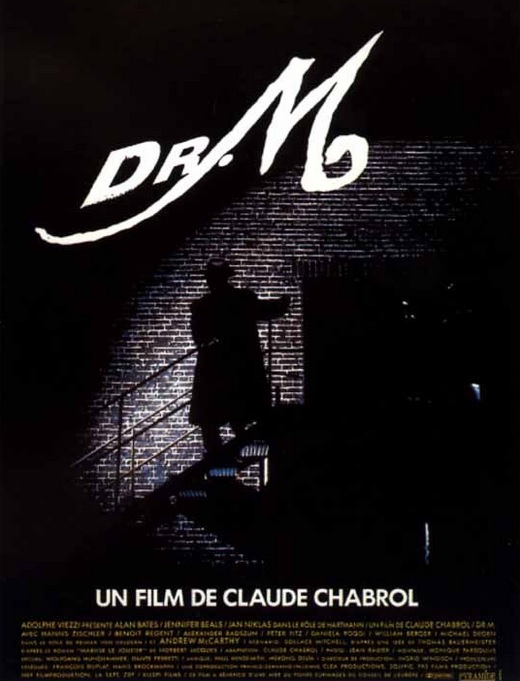While not a household name in the U.S., director Claude Chabrol (with films like Bluebeard and 1975’s Innocents with Dirty Hands) is revered in his homeland—and throughout Europe—alongside other prominent, “mainstream” filmmakers birthed from the ‘50s French New Wave: Francois Truffaut (1966’s sci-fi Fahrenheit 451) and Jean-Luc Godard (1965’s sci-fi Alphaville).

Inspired by German Expressionist filmmaker Fritz Lang (1932’s apoc-futuristic Metropolis) and Alfred Hitchcock’s oeuvre, Chabrol is best known to U.S. audiences for his 1969 (written/directed) foreign hit, La Femme infidel (The Unfaithful Wife). A Fatal Attraction-esque husband-murders-lover-of-cheating-wife thriller, Chabrol’s film received renewed interest when remade by that film’s director, Adrian Lynne, as Unfaithful (2002; with Richard Gere and Diane Lane).
When the centenary year of Lang’s birthday came around, Chabrol decided to pay tribute to his cinematic idol with a futurist-Metropolis spin to Fritz Lang’s 1922 silent, two-part mystery-masterpiece, Dr. Mabuse: The Great Gambler and Inferno*. Most likely—with a cast featuring Jennifer Beals of Flashdance fame (as Sonja Vogler) and Andrew McCarthy (as an “assassin”; his appearance, so brief, it doesn’t warrant his top-billing)—this admittedly low-budget yet engrossing film (titled Dr. M throughout Europe) was criminally slapped with a hackneyed, U.S. teen-slasher title due to its American-based stars: Club Extinction, for its domestic home video bow.
In a cost-effective, not-too-distant Bladerunner future, Berlin (remember, the Berlin Wall didn’t fall until November 1991; so it is still standing in this “future”), a police inspector (as in the aforementioned-linked Alphaville) traverses the city in his investigation of an “outbreak” of shocking-spectacular suicides that “plague” the city. Clues soon lead him to a “Big Brother” multimedia combine (as in Kamikaze ’89). The combine employs his lover, Sonja, as the spokeswoman for a series of commercials with a sinister, clandestine purpose (as in John Carpenter’s They Live; more accurately, David Cronenberg’s Videodrome): to hypnotize and control, and eventually destroy humanity (in Charbrol’s case: a Hitler metaphor).
The “Fuhrer” behind the plot: Dr. Mardsfeldt (the always incredible Alan Bates; Paul Newman’s post-apoc bow, 1979’s Quintet), who passes himself off as a self-help guru at a remote holiday “health” resort—complete with a “life support system” in a control room (read: brainwashing) for a Jim Jones-styled religious cult. And, Crazy Imagery Alert: One that only Chabrol can dream and commit to film: Bates and Beals having sex—intercut with images of war and destruction (interpret that how you will).
This examination of the life of Adolf Hitler and the goals of a Fascist dictatorship reminds us that, while the world reviled him as evil incarnate, Hitler saw himself as sane, righteous and justified. In most films, we encounter evil, cackling, mustache-twisting Castor Troy’s (Nicolas Cage in Face/Off). That is not how an “evil reality” thinks or operates. Dr. M doesn’t see himself as evil. In his mind, his goal is a logically sane endgame (and Bates plays it close to the chest; no histrionics). And technology, in the wrong hands—as we now experience in today’s modern world (as with the current vaping epidemic)—can be detrimental to humanity.
* Lang brought the character back for two sound-sequels: The Testament of Dr. Mabuse (1933) and The Thousand Eyes of Dr. Mabuse (1960), each starring Rudolf Klein-Rogge as the doctor. Then, five more German sequels were made, after Lang’s final Mabuse film in 1960 and prior to Chabrol’s variant: The Return of Dr. Mabuse (1961), The Invisible Dr. Mabuse (1962), The Testament of Dr. Mabuse (1962), Scotland Yard Hunts Dr. Mabuse (1963), and The Secret of Dr. Mabuse (1964). Dr. Mabuse fans will, of course, note, there are other sequels: The Vengeance of Dr. Mabuse (1972), along with sequels in 2013, 2014, and 2020.
Update: April 2022: Arrow Video has since honored Claude Chabrol‘s career with two box sets: Twisting the Knife and Lies & Deceit—sets which we have reviewed in full. Within those reviews, you’ll find individual reviews for each film in the set. Other Chabrol films we’ve reviewed include his Eurospy romp, Blue Panther, and his retelling of Alice in Wonderland, as Alice or the Last Escapade.
About the Author: You can read the music and film reviews of R.D Francis on Medium and learn more about his work on Facebook.

